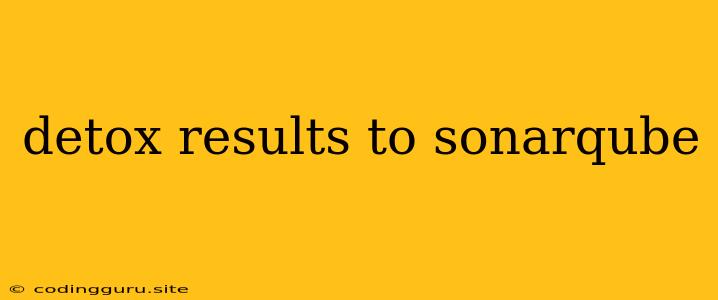Understanding Detox Results in SonarQube
Detox is a powerful testing framework for React Native applications. It allows developers to test their applications in a real-world environment, simulating user interactions and ensuring that the app functions as expected. SonarQube, on the other hand, is a popular open-source platform for continuous inspection of code quality. It analyzes your codebase and provides insights into potential bugs, security vulnerabilities, and code style violations.
But how can you leverage the power of Detox and bring its results into SonarQube? This is a question that many developers grapple with, especially when striving for comprehensive code quality analysis and continuous integration pipelines.
The Need for Integration
Integrating Detox results with SonarQube offers several key advantages:
- Comprehensive Code Quality Analysis: By combining functional testing insights from Detox with SonarQube's static code analysis, you gain a more holistic view of your code's health.
- Early Bug Detection: Integrating Detox tests into your CI/CD pipeline allows you to catch potential bugs early on, preventing them from reaching production and reducing costly fixes later.
- Improved Code Maintainability: SonarQube can analyze your code for technical debt, code complexity, and other metrics that can impact maintainability. Detox results provide a functional perspective, ensuring that changes don't break existing functionality.
- Enhanced Collaboration: Having all your code quality data in one place simplifies collaboration between developers, testers, and project managers, improving overall development efficiency.
The Challenge of Integrating Detox and SonarQube
While the benefits are clear, integrating Detox results into SonarQube isn't as straightforward as it seems. Detox is designed for functional testing, focusing on how the application behaves. SonarQube, on the other hand, focuses on the code itself. This discrepancy in focus means that a direct integration isn't readily available.
Bridging the Gap: Solutions and Workarounds
There are a few approaches you can take to effectively bring Detox results into SonarQube:
- Custom Plugins: You can write a custom plugin for SonarQube that processes Detox test results and displays them within the SonarQube interface. This would require strong coding skills and an understanding of SonarQube's plugin architecture.
- Third-Party Tools: Some third-party tools might offer integration between Detox and SonarQube, but these solutions are often proprietary and come with licensing costs.
- Code Coverage Analysis: While not a direct integration, you can analyze your code coverage from Detox tests and report it to SonarQube as a custom metric. This provides an indirect measure of the quality of your functional tests.
Code Coverage Analysis: A Practical Solution
Using code coverage analysis is a practical workaround for integrating Detox results into SonarQube.
- Configure Detox Tests: Ensure that your Detox tests are instrumented to collect code coverage data. Most code coverage tools, such as Istanbul or Jest, integrate with Detox and provide this functionality.
- Generate Coverage Reports: After running your Detox tests, generate a code coverage report in a format that SonarQube can understand, like the standard Cobertura XML format.
- Custom SonarQube Metric: Configure SonarQube to recognize and process your custom code coverage report.
- Analyze Coverage Results: Interpret the code coverage data in SonarQube to identify areas of your application that might be lacking sufficient test coverage.
Example:
// your-detox-test.js
const detox = require('detox');
const adapter = require('detox/runners/jest/adapter');
describe('Example Detox Test', () => {
beforeAll(async () => {
await detox.init(adapter);
});
beforeEach(async () => {
await detox.device.reloadReactNative();
});
afterEach(async () => {
// You can add assertions to the afterEach callback
});
afterAll(async () => {
await detox.cleanup();
});
it('should render the welcome screen', async () => {
// Test code for checking the welcome screen
});
});
// your-detox-test.config.js
module.exports = {
runner: 'jest-runner-detox',
testPathIgnorePatterns: ['node_modules'],
setupFiles: ['/detoxSetup.js'],
reporters: [
'jest-preset-react-native',
['jest-sonar', {
reportFile: '/coverage/coverage.xml'
}]
]
};
Conclusion
Integrating Detox results with SonarQube requires a combination of technical expertise and creative problem-solving. While a direct integration might not be readily available, solutions like code coverage analysis offer a viable path to incorporate Detox insights into your continuous code quality monitoring.
By adopting this approach, you can achieve a more comprehensive understanding of your application's quality, proactively identify potential issues, and enhance the overall development process. Remember, the key is to leverage the strengths of both Detox and SonarQube to create a robust and efficient testing and code analysis workflow.
